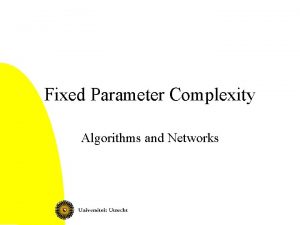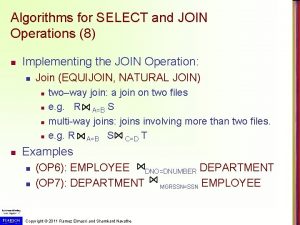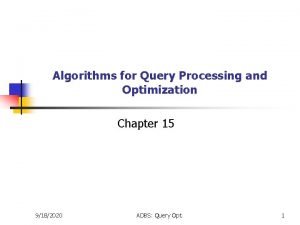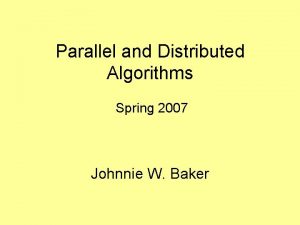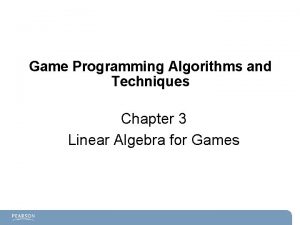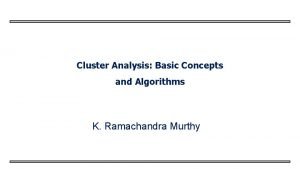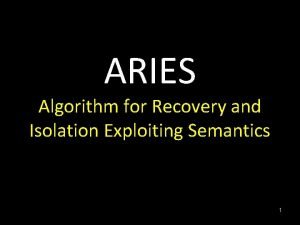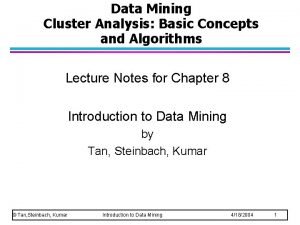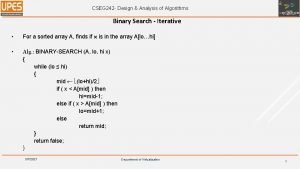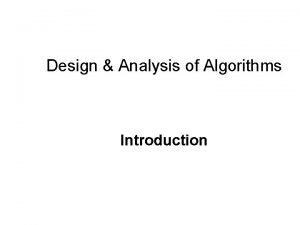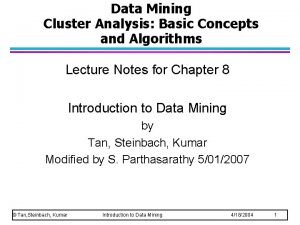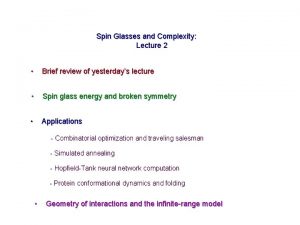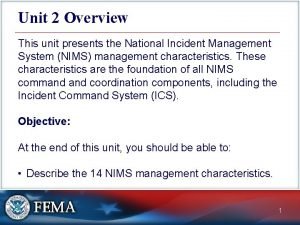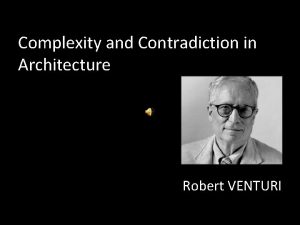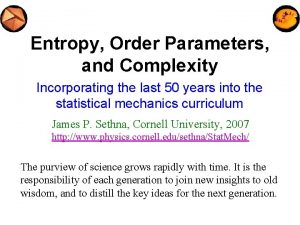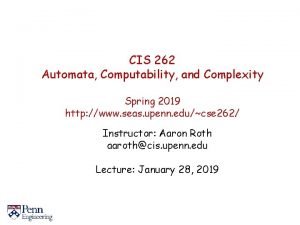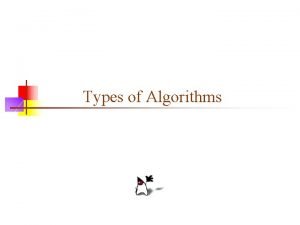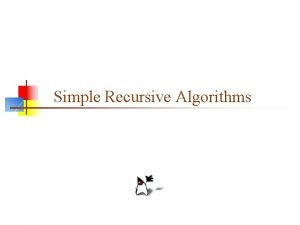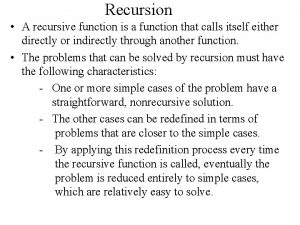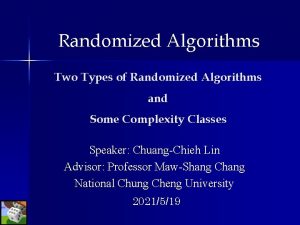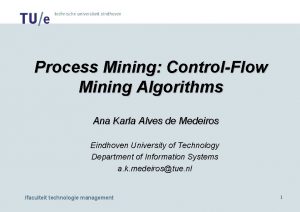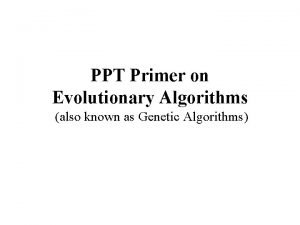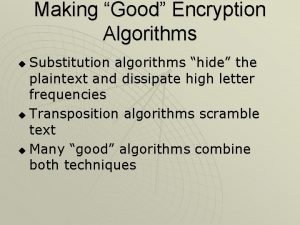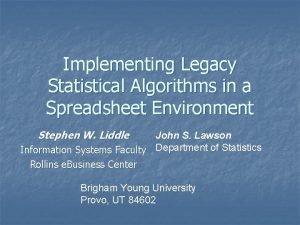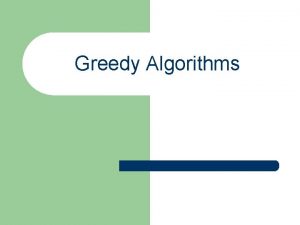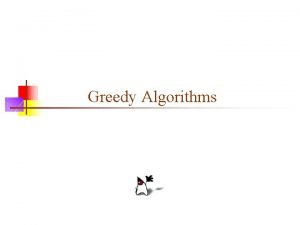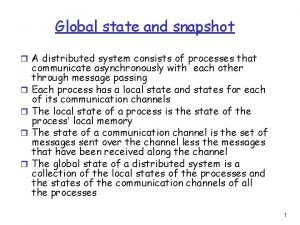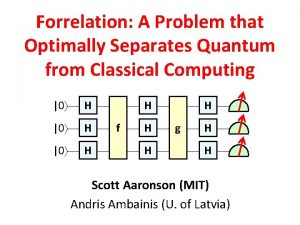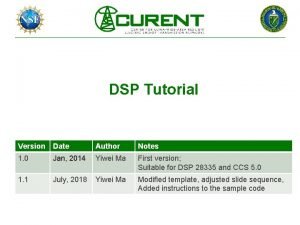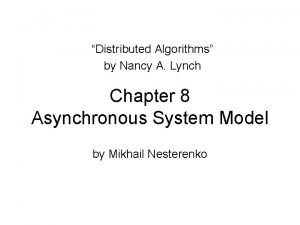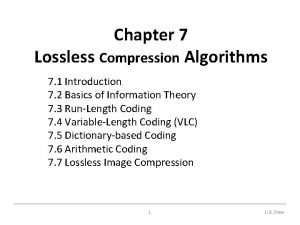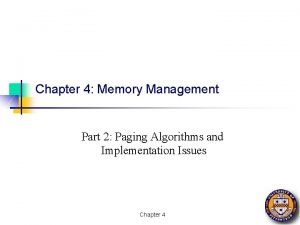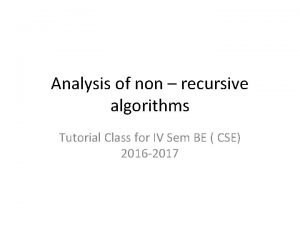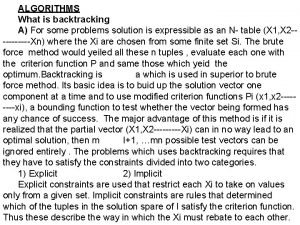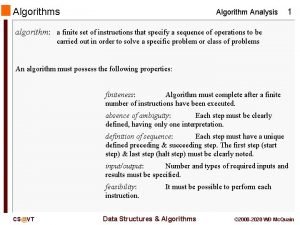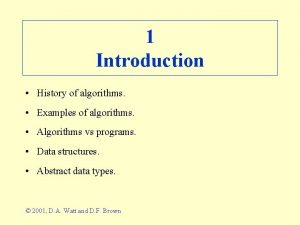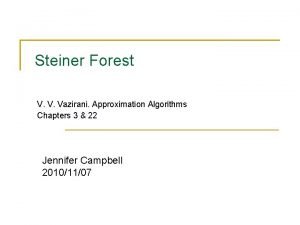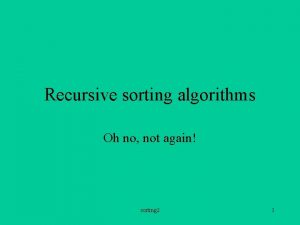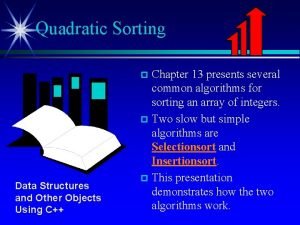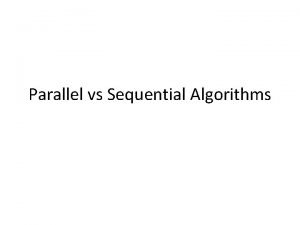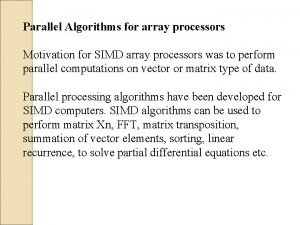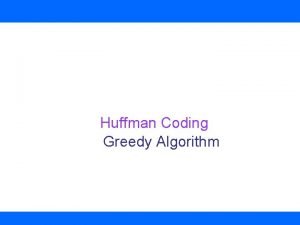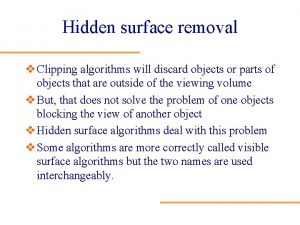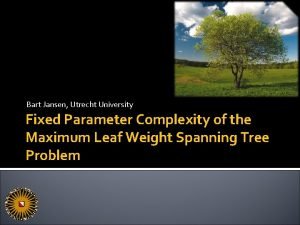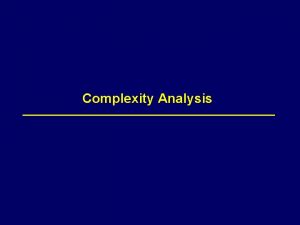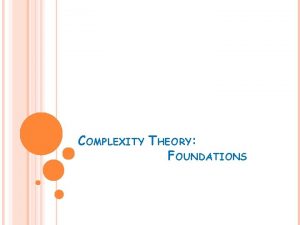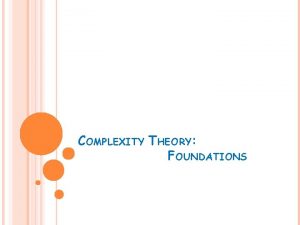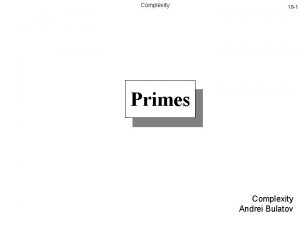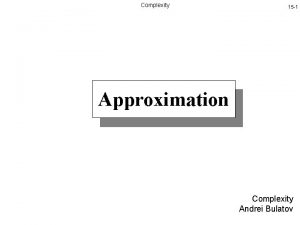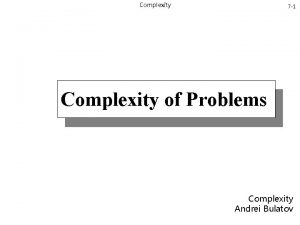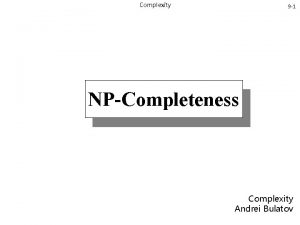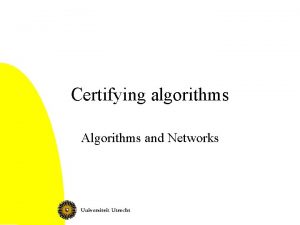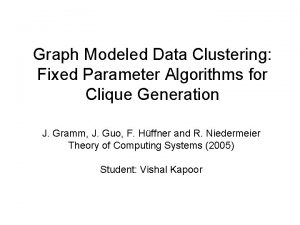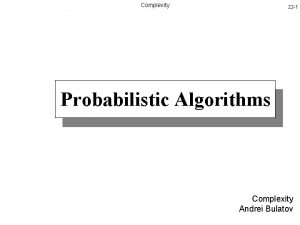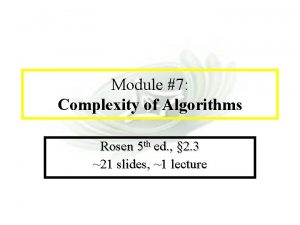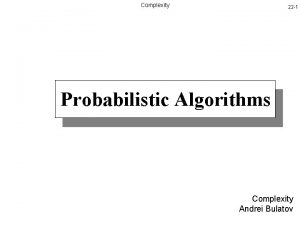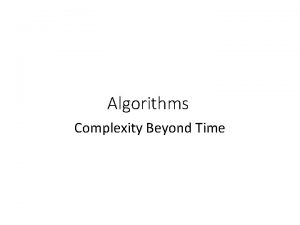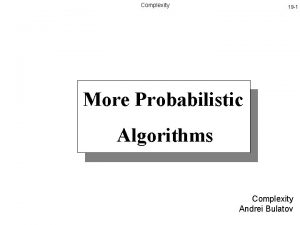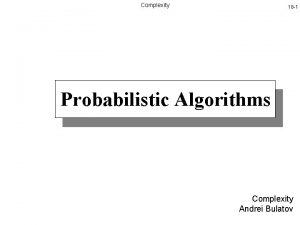Fixed Parameter Complexity Algorithms and Networks Fixed parameter












![Hard problems • Complexity classes – FPT Í W[1] Í W[2] Í … W[i] Hard problems • Complexity classes – FPT Í W[1] Í W[2] Í … W[i]](https://slidetodoc.com/presentation_image_h/362dd231d638b34de3ab874da42736b9/image-13.jpg)
![Examples of hard problems • Clique and Independent Set are W[1]-complete • Dominating Set Examples of hard problems • Clique and Independent Set are W[1]-complete • Dominating Set](https://slidetodoc.com/presentation_image_h/362dd231d638b34de3ab874da42736b9/image-14.jpg)
































![Consequence • If a problem is W[1]-hard, it has no kernel, unless FPT=W[1] • Consequence • If a problem is W[1]-hard, it has no kernel, unless FPT=W[1] •](https://slidetodoc.com/presentation_image_h/362dd231d638b34de3ab874da42736b9/image-47.jpg)

















































![Compression subroutine G[{v 1, v 2, …, vi}] X 97 Fixed Parameter Complexity Compression subroutine G[{v 1, v 2, …, vi}] X 97 Fixed Parameter Complexity](https://slidetodoc.com/presentation_image_h/362dd231d638b34de3ab874da42736b9/image-97.jpg)

![Compression subroutine G[{v 1, v 2, …, vi}] X 99 Fixed Parameter Complexity Compression subroutine G[{v 1, v 2, …, vi}] X 99 Fixed Parameter Complexity](https://slidetodoc.com/presentation_image_h/362dd231d638b34de3ab874da42736b9/image-99.jpg)
![Compression subroutine G[{v 1, v 2, …, vi}] X 100 Fixed Parameter Complexity Compression subroutine G[{v 1, v 2, …, vi}] X 100 Fixed Parameter Complexity](https://slidetodoc.com/presentation_image_h/362dd231d638b34de3ab874da42736b9/image-100.jpg)
![Compression subroutine G[{v 1, v 2, …, vi}] X 101 Fixed Parameter Complexity Compression subroutine G[{v 1, v 2, …, vi}] X 101 Fixed Parameter Complexity](https://slidetodoc.com/presentation_image_h/362dd231d638b34de3ab874da42736b9/image-101.jpg)

![Other case G[{v 1, v 2, …, vi}] X 103 Fixed Parameter Complexity Other case G[{v 1, v 2, …, vi}] X 103 Fixed Parameter Complexity](https://slidetodoc.com/presentation_image_h/362dd231d638b34de3ab874da42736b9/image-103.jpg)







- Slides: 110

Fixed Parameter Complexity Algorithms and Networks

Fixed parameter complexity • Analysis what happens to problem when some parameter is small • Today: – Definitions – Fixed parameter tractability techniques • Branching • Kernelisation • Other techniques 2

Motivation • In many applications, some number may be assumed to be small – Time of algorithm can be exponential in this small number, but should be polynomial in usual size of problem 3

Example: Can you pick 7 vertices that hit all edges? 4

Example: Can you pick 7 vertices that hit all edges? 5

Parameterized graph problem • Given: Graph G, integer k, … • Parameter: k • Question: Does G have a ? ? ? of size at least (at most) k? – Examples: vertex cover, independent set, coloring, … 6

Examples of parameterized problems (1) Graph Coloring Given: Graph G, integer k Parameter: k Question: Is there a vertex coloring of G with k colors? (I. e. , c: V ® {1, 2, …, k} with for all {v, w}Î E: c(v) ¹ c(w)? ) • NP-complete, even when k=3. 7

Examples of parameterized problems (2) Clique Given: Graph G, integer k Parameter: k Question: Is there a clique in G of size at least k? • Solvable in O(nk+1) time with simple algorithm. Complicated algorithm gives O(n 2. 23 k/3). Seems to require W(nf(k)) time… 8

Examples of parameterized problems (3) Vertex cover Given: Graph G, integer k Parameter: k Question: Is there a vertex cover of G of size at most k? • Solvable in O(2 k (n+m)) time 9

Fixed parameter complexity theory • To distinguish between behavior: ØO( f(k) * nc) ØW( nf(k)) • Proposed by Downey and Fellows. 10

Parameterized problems • Instances of the form (x, k) – I. e. , we have a second parameter • Decision problem (subset of {0, 1}* x N ) 11

Fixed parameter tractable problems • FPT is the class of problems with an algorithm that solves instances of the form (x, k) in time p(|x|)*f(k), for polynomial p and some function f. 12
![Hard problems Complexity classes FPT Í W1 Í W2 Í Wi Hard problems • Complexity classes – FPT Í W[1] Í W[2] Í … W[i]](https://slidetodoc.com/presentation_image_h/362dd231d638b34de3ab874da42736b9/image-13.jpg)
Hard problems • Complexity classes – FPT Í W[1] Í W[2] Í … W[i] Í … Í W[P] – FPT is ‘easy’, all others ‘hard’ – Defined in terms of Boolean circuits – Problems hard for W[1] or larger classes are assumed not to be in FPT • Compare with P / NP 13
![Examples of hard problems Clique and Independent Set are W1complete Dominating Set Examples of hard problems • Clique and Independent Set are W[1]-complete • Dominating Set](https://slidetodoc.com/presentation_image_h/362dd231d638b34de3ab874da42736b9/image-14.jpg)
Examples of hard problems • Clique and Independent Set are W[1]-complete • Dominating Set is W[2]-complete • This version of Satisfiability is W[1]-complete – Given: set of clauses, k – Parameter: k – Question: can we set (at most) k variables to true, and al others to false, and make all clauses true? 14

Techniques for showing fixed parameter tractability • • 15 Branching Kernelisation Iterative compression Other techniques (e. g. , treewidth)

A branching algorithm for vertex cover • Idea: – Simple base cases – Branch on an edge: one of the endpoints belongs to the vertex cover • Input: graph G and integer k 16

A branching algorithm for vertex cover • Recursive procedure VC(Graph G, int k) • VC(G=(V, E), k) – If G has no edges, then return true – If k == 0, then return false – Select an edge {v, w} Î E – Compute G’ = G [V – v] – Compute G” = G [V – w] – Return VC(G’, k – 1) or VC(G”, k – 1) 17

18

v 5 v 6 19 w w

v 5 v 6 20 w w

w 5 v w 6 v 5 21 w

w 5 v w 6 v 5 22 w

w 5 v w 6 v 5 23

Analysis of algorithm • Correctness – Either v or w must belong to an optimal VC • Time analysis – Branching tree has 2 k leaves, so 2 k recursive calls – Each recursive call costs O(n+m) time – O(2 k (n+m)) time: FPT 24

Cluster editing • Instance: undirected graph G=(V, E), integer K • Parameter: K • Question: can we make at most K modifications to G, such that each connected component is a clique, where each modification is an addition of an edge or the deletion of an edge? • Models biological question: partition species in families, where available data contains mistakes • NP-complete. Branching: O(3 k p(n)) algorithm 25

Lemma • If G has a connected • Proof: there are component that is not vertices w and x in the a clique, then G connected component contains the following that are not adjacent. subgraph: Take such w and x of w minimum distance, which must be 2. v 26 x

Branching algorithm for Cluster Editing • If each connected component is a clique: – Answer YES • If k=0 and some connected components are not cliques: – Answer NO • Otherwise, there must be vertices v, w, x with {v, w} Î E, {v, x} Î E, and {w, x}Ï E w – Go three times in recursion: • Once with {v, w} removed and k = k – 1 • Once with {v, x} removed and k = k – 1 • Once with {w, x} added and k = k – 1 27 v x

Analysis branching algorithm • Correctness by lemma • Time analysis: branching tree has 3 k leaves 28

More on cluster editing • Faster branching algorithms exist • Important applications and practical experiments • We’ll see more when discussing kernelisation 29 Fixed Parameter Complexity

Max SAT • Variant of satisfiability, but now we ask: can we satisfy at least k clauses? • NP-complete • With k as parameter: FPT • Branching: – Take a variable – If it only appears positively, or negatively, then … – Otherwise: Branch! What happens with k? 30 Fixed Parameter Complexity

Independent Set on Planar Graphs • Given: a planar graph G=(V, E), integer k • Parameter: k • Question: Does G have an independent set of at least k vertices, i. e. , a set W of size at least k, such that for all v, w in W: {v, w} is not an edge? • NP-complete problem • Here we argue O(6 k n) algorithm (faster is possible) 31 Fixed Parameter Complexity

The red vertices form an independent set 32

Branching • Each planar graph has a vertex of degree at most 5 • Take vertex v of minimum degree, say with neighbors w 1, …, wr, r at most 5 • A maximum size independent set contains v or one of its neighbors – Selecting a vertex is equivalent to removing it and its neighbors and decreasing k by one • Create at most 6 subproblems, one for each x Î {v, w 1, …, wr}. In each, we set k = k – 1, and remove x and its neighbors 33

v w 1 w 2 34

Closest string Given: k strings s 1, …, sk each of length L, integer d Parameter: d Question: is there a string s with Hamming distance at most d to each of s 1, …, sk • Application in molecular biology • Here: FPT algorithm • (Gramm and Niedermeier, 2002) 35

Subproblems • Subproblems have form – Candidate string s – Additional parameter r – We look for a solution to original problem, with additional condition: • Hamming distance at most r to s • Start with s = s 1 and r=d (= original problem) 36

Branching step • Choose an sj with Hamming distance > d to s – If none exists, s is a solution • If Hamming distance of sj to s > d+r: answer NO • For all positions i where sj differs from s – Solve subproblem with • s changed at position i to value sj (i) • r = r – 1 • Note: we find a solution, if and only one of these subproblems has a solution 37

Example • Strings 01113, 02223, 01221, d=2 gives – (02113, 1) • (02213, 0) • (02123, 0) – (01213, 1) • (02213, 0) • (01223, 0) – (01123, 1) • (02123, 0) • (01223, 0) 38

Time analysis • Recursion depth d • At each level, we branch at most at d + r £ 2 d positions • So, number of recursive steps at most (2 d)d+1 • Each step can be done in polynomial time: O(kd. L) • Total time is O((2 d)d+1. kd. L) • Speed up possible by more clever branching and by kernelisation 39

More clever branching step • Choose an sj with Hamming distance > d to s – If none exists, s is a solution • If Hamming distance of sj to s > d+r: answer NO • Choose pick d+1 positions where sj differs from s – Solve subproblem with • s changed at position i to value sj (i) • r = r – 1 • Still correct since the solution differs with s on at least one of these positions. O(k. L + kd (d+1)d) time 40

Technique • Try to find a branching rule that – Decreases the parameter – Splits in a bounded number of subcases • YES, if and only if YES in at least one subcase 41

Kernelization

Kernelisation • Preprocessing rules reduce starting instance to one of size f(k) – Should work in polynomial time • Then use any algorithm to solve problem on kernel • Time will be p(n) + g(f(k)) 43

Kernelisation • Helps to analyze preprocessing • Much recent research • Today: definition and some examples 44

Formal definition of kernelisation • Let P be a parameterized problem. (Each input of the form (I, k). ) A reduction to a problem kernel is an algorithm A, that transforms inputs of P to inputs of P, such that – (I, k) Î P, if and only if A(I, k) Î P for all (I, k) – If A(I, k) = (I’, k’), then k’ £ f(k), and |I’| £ g(k) for some functions f, g – A uses time, polynomial in |I| and k 45

Kernels and FPT • Theorem. Consider a decidable parameterized problem. Then the problem belongs to FPT, if and only if it has a kernel • <= Build kernel and solve the problem on kernel • => Suppose we have an f(k)nc algorithm. Run the algorithm for nc+1 steps. If it did not yet solve the problem, return the input as kernel: it has size at most f(k). If it solved the problem, then return small YES / NO instance 46 Fixed Parameter Complexity
![Consequence If a problem is W1hard it has no kernel unless FPTW1 Consequence • If a problem is W[1]-hard, it has no kernel, unless FPT=W[1] •](https://slidetodoc.com/presentation_image_h/362dd231d638b34de3ab874da42736b9/image-47.jpg)
Consequence • If a problem is W[1]-hard, it has no kernel, unless FPT=W[1] • There also exist techniques to give evidence that problems have no kernels of polynomial size – If problem is compositional and NP-hard, then it has no polynomial kernel – Example is e. g. , LONG PATH 47 Fixed Parameter Complexity

First kernel: Convex string recoloring • Application from molecular biology; NP-complete Convex String Recoloring – Given: string s in S*, integer k – Parameter: k – Question: can we change at most k characters in the string s, such that s becomes convex, i. e. , for each symbol, the positions with that symbol are consecutive. • Example of convex string: aaacccbxxxffff • Example of string that is not convex: abba • Instead of symbols, we talk about colors 48

Kernel for convex string recoloring • Theorem: Convex string recoloring has a kernel with O(k 2) characters. 49

Notions • Notion: good and bad colors • A color is good, if it is consecutive in s, otherwise it is bad • abba: a is bad and b is good • Notion of block: consecutive occurrences of the same color, ie. aabbacc has four blocks • Convex: each color has one block 50

Construction of kernel • Apply three reduction rules – Rule 1: limit #blocks of bad colors – Rule 2: limit #different good colors – Rule 3: limit #characters in s per block • Count 51

Rule 1 • If there are more than 4 k blocks of bad colors, say NO – Formally, transform to trivial NO-instance, e. g. (aba, 0) – Why correct? • Each change can decrease the number of blocks of bad colors by at most 4. – Example: abab -> abbb 52

Rule 2 • If we have two consecutive blocks of good colors, then change the color of the second block to that of the first • E. g: abbbbcca -> abbbbbba • Why correct? – We will only recolor the c’s to connect bad colors, and this still comes at the same cost. 53

Rule 3 • If a block has more than k+1 characters, delete all but k+1 of the block • Correctness: a block of such a size can never be changed 54

Counting • After the rules have been applied, we have at most: – 4 k blocks of bad colors – 4 k+1 blocks of good colors: at most one between each pair of bad colors, one in front and one in the end – Each block has size at most k+1 • String has size at most (8 k+1)(k+1) • This can be improved by better analysis, more rules, . . . 55

Fixed Parameter Complexity nd half) (2 Reminder • • Kernelization: – – – Point line cover (warm-up) Vertex Cover Max Sat Cluster editing Non-blocker (might skip it) • FPT techniques: – Iterative Compression – Color Coding 56 Fixed Parameter Complexity

Reminder: Fixed Parameter Complexity • Given: Graph G, integer k, … • Parameter: k • Question: Does G have a ? ? ? of size at least (at most) k? • Distinguish between behavior: ØO( f(k) * nc) ØW( nf(k)) 57

Reminder: Kernelisation • Let P be a parameterized problem. (Each input of the form (I, k). ) A reduction to a problem kernel is an algorithm A, that transforms inputs of P to inputs of P, such that – (I, k) Î P, if and only if A(I, k) Î P for all (I, k) – If A(I, k) = (I’, k’), then k’ £ f(k), and |I’| £ g(k) for some functions f, g – A uses time, polynomial in |I| and k 58

Kernel: Point-line cover In: n points in the plane, integer k Question: Can you hit all the points with k straight lines? NP-Complete. 59 Fixed Parameter Complexity

Quadratic kernel Rule 1: If some line covers k+1 points use it (and reduce k by one). Rule 2: If Rule 1 is not applicable and n > k 2, say NO. Kernel with k 2 points! 60

Vertex cover: observations that help for kernelisation • Isolated vertices can be ignored • If v has degree at least k+1, v belongs to each vertex cover in G of size at most k. – If v is not in the vertex cover, then all its neighbors are in the vertex cover. • If all vertices have degree at most k, and m > k 2, there is no vertex cover of size k. 61

Kernelisation for Vertex Cover H = G; ( S = Æ; ) While there is a vertex v in H of degree at least k+1 do Remove v and its incident edges from H k = k – 1; ( S = S + v ; ) If k < 0 then return false If H has at least k 2+1 edges, then return false Remove vertices of degree 0 62

Time • Kernelisation step can be done in O(n+m) time • After kernelisation, we must solve the problem on a graph with at most k 2 edges, e. g. , with branching this gives: – O( n + m + 2 k k 2) time – O( kn + 2 k k 2) time can be obtained by noting that there is no solution when m > kn. 63

Better kernel for vertex cover • • • Nemhauser-Trotter: kernel of at most 2 k vertices Make ILP formulation of Vertex Cover Solve relaxation All vertices v with xv > ½ : put v in set All vertices v with xv < ½ : v is not in the set Remove all vertices except those with value ½, and decrease k accordingly • Gives kernel with at most 2 k vertices, but why is it correct? 64

Nemhauser Trotter proof plan • 65

1. ILP 66

2. Relaxation 67

3. Observation • 68 Fixed Parameter Complexity

3. Observation • added 69 deleted Fixed Parameter Complexity

3. Observation • added 70 deleted Fixed Parameter Complexity

2 k kernel for Vertex Cover • Solve the relaxation (polynomial time with the ellipsoid method, practical with Simplex) • If the relaxation has optimum more than k, then say no • Otherwise, get rid of the 0’s and 1’s, decrease k accordingly • At most 2 k vertices have weight ½ in the relaxation • So, kernel has 2 k vertices. • It can (and will often) have a quadratic number of edges 71

Maximum Satisfiability Given: Boolean formula in conjunctive normal form; integer k Parameter: k Question: Is there a truth assignment that satisfies at least k clauses? • Denote number of clauses with C 72

Reducing the number of clauses • 73

Bounding number of long clauses • • Long clause: has at least k literals Short clause: has at most k-1 literals Let L be number of long clauses If L ³ k: answer is YES – Select in each of the first k long clauses a literal, whose complement is not yet selected – Set these all to true – At least k long clauses are satisfied 74

Reducing to only short clauses • If less than k long clauses – Make new instance, with only the short clauses and the parameter set to k-L – Valid, because: there is a truth assignment that satisfies at least k-L short clauses, if and only if there is a truth assignment that satisfies at least k clauses • =>: choose for each satisfied short clause a variable that makes the clause true. We may change all other variables, and can choose for each long clause another variable that makes it true • <=: there are only L long clause so we satisfy k-L short ones 75

An O(k 2) kernel for Maximum Satisfiability • If at least 2 k clauses then return YES • If at least k long clauses then return YES • Else – remove all L long clauses – set k=k-L 76

Reminder: Cluster editing • Instance: undirected graph G=(V, E), integer K • Parameter: K • Question: can we make at most K modifications to G, such that each connected component is a clique, where each modification is an addition of an edge or the deletion of an edge? 77

Kernelisation for cluster editing • Quadratic kernel • General form: • Repeat rules, until no rule is possible – Rules can do some necessary modification and decrease k by one – Rules can remove some part of the graph – Rules can output YES or NO 78

Trivial rules and plan • Rule 1: If a connected component of G is a clique, remove this connected component • Rule 2: If we have more than k connected components and Rule 1 does not apply: Answer NO • Consequence: after Rule 1 and Rule 2, there at most k connected components • Plan: find rules that make connected component small • We change the input: some pairs are permanent and others are forbidden. 79

Observation and rule 3 • If two vertices v, w have k+1 neighbors in common, they must belong to the same clique in a solution Rule 3: If v, w have k+1 neighbors in common, then – If {v, w} did not exist, add it, and set k = k – 1. – Set the edge {v, w} to be permanent 80

Another observation and rule 4 • If there at least k+1 vertices that are adjacent to exactly one of v and w, then {v, w} cannot be an edge in the solution Rule 4: If there at least k+1 vertices that are adjacent to exactly one of v and w, then – If {v, w} is an edge: delete it and decrease k by one v – Mark the pair {v, w} as forbidden w 81

A trivial rule • Rule 5: if a pair is forbidden and permanent then there is no solution 82 Fixed Parameter Complexity

Transitivity • Rule 6: if {v, w} is permanent, and {w, x} is permanent, then set {v, x} to be permanent (if the edge was nonexisting, add it, and decrease k by one) • Rule 7: if {v, w} is permanent and {w, x} is forbidden, then set {v, x} to be forbidden (if the edge existed, delete it, and decrease k by one) 83

Counting • Rules can be executed in polynomial time • One can find in O(n 3) time an instance to which no rules apply (with properly chosen data structures) Claim: If no rule applies, and the instance is a YES-instance, then every connected component has size at most 4 k. Proof: • Suppose a YES-instance, and consider a connected component C of size at least 4 k+1. • At least 2 k+1 vertices are not involved in a modification, say this is the set W • W must form a clique, and all edges in W become permanent (Rule 3) … 84

Counting continued • 85

Conclusion • Rule 8: If no other rule applies, and there is a connected component with at least 4 k+1, vertices, say NO. • As we have at most k connected components, each of size at most 4 k, our kernel has at most 4 k 2. 86 Fixed Parameter Complexity

Comments • This argument is due to Gramm et al. • Better and more recent algorithms exist: faster algorithm (2. 7 k) and linear kernels 87

Non-blocker • Given: graph G=(V, E), integer k • Parameter k • Question: Does G have a dominating set of size at most |V|-k ? 88

Lemma and simple linear kernel • If G does not have vertices of degree 0, then G has a dominating set with at most |V|/2 vertices – Proof: per connected component: build spanning tree. The vertices on the odd levels form a ds, and the vertices on the even levels form a ds. Take the smallest of these. • 2 k kernel for non-blocker after removing vertices of degree 0 89

Improvements • Lemma (Blank and Mc. Cuaig, 1973) If a connected graph has minimum degree at least two and at least 8 vertices, then the size of a minimum dominating set is at most 2|V|/5. • Lemma (Reed) If a connected graph has minimum degree at least three, then the size of a minimum dominating set is at most 3|V|/8. • Can be used by applying reduction rules for killing degree one and degree two vertices 90

Iterative compression 91

Feedback Vertex Set • Instance: graph G=(V, E) • Parameter: integer k • Question: Is there a set of at most k vertices W, such that G-W is a forest? – – 92 Known in FPT Here: recent algorithm O(5 k p(n)) time algorithm Can be done in O(5 k kn) or less with kernelisation Fastest known algorithm (randomized): O(3 k p(n)), invented at Utrecht, using treewidth techniques.

Iterative compression technique • Number vertices v 1, v 2, …, vn • Let X = {v 1, v 2, …, vk} • for i = k+1 to n do • Add vi to X – Note: X is a FVS of size at most k+1 of G[{v 1, v 2, …, vi}] • Call a subroutine that either – Finds (with help of X) a feedback vertex set Y of size at most k in {v 1, v 2, …, vi}; set X = Y OR – Determines that such Y does not exist; stop, return NO 93

Compression subroutine • Given: graph G, FVS X of size k + 1 • Question: find if existing FVS of size k – Is subroutine of main algorithm Ø for all subsets S of X do Determine if there is a FVS of size at most k that contains all vertices in S and no vertex in X – S 94

Yet a deeper subroutine • • 1. 2. 3. 4. 5. 6. 7. 95 Given: Graph G, FVS X of size k+1, set S Question: find if existing a FVS of size k containing all vertices in S and no vertex from X – S Remove all vertices in S from G Mark all vertices in X – S If marked cycles contain a cycle, then return NO While marked vertices are adjacent, contract them Set k = k - |S|. If k < 0, then return NO If G is a forest, then return YES; S …

Compression subroutine Answer NO, we cannot kill this cycle since we don’t remove any vertex. G[{v 1, v 2, …, vi}] X S 96 Fixed Parameter Complexity
![Compression subroutine Gv 1 v 2 vi X 97 Fixed Parameter Complexity Compression subroutine G[{v 1, v 2, …, vi}] X 97 Fixed Parameter Complexity](https://slidetodoc.com/presentation_image_h/362dd231d638b34de3ab874da42736b9/image-97.jpg)
Compression subroutine G[{v 1, v 2, …, vi}] X 97 Fixed Parameter Complexity

Subroutine continued 7. If an unmarked vertex v has at least two edges to marked vertices • If these edges are parallel, i. e. , to the same neighbor, then v must be in a FVS (we have a cycle with v the only unmarked vertex) • • Put v in S, set k = k – 1 and recurse Else recurse twice: • • Put v in S, set k = k – 1 and recurse Mark v, contract v with all marked neighbors and recurse – 98 The number of marked vertices is one smaller
![Compression subroutine Gv 1 v 2 vi X 99 Fixed Parameter Complexity Compression subroutine G[{v 1, v 2, …, vi}] X 99 Fixed Parameter Complexity](https://slidetodoc.com/presentation_image_h/362dd231d638b34de3ab874da42736b9/image-99.jpg)
Compression subroutine G[{v 1, v 2, …, vi}] X 99 Fixed Parameter Complexity
![Compression subroutine Gv 1 v 2 vi X 100 Fixed Parameter Complexity Compression subroutine G[{v 1, v 2, …, vi}] X 100 Fixed Parameter Complexity](https://slidetodoc.com/presentation_image_h/362dd231d638b34de3ab874da42736b9/image-100.jpg)
Compression subroutine G[{v 1, v 2, …, vi}] X 100 Fixed Parameter Complexity
![Compression subroutine Gv 1 v 2 vi X 101 Fixed Parameter Complexity Compression subroutine G[{v 1, v 2, …, vi}] X 101 Fixed Parameter Complexity](https://slidetodoc.com/presentation_image_h/362dd231d638b34de3ab874da42736b9/image-101.jpg)
Compression subroutine G[{v 1, v 2, …, vi}] X 101 Fixed Parameter Complexity

Other case All unmarked vertices have at most 2 marked neighbors! 8. Choose an unmarked vertex v that has at most one unmarked neighbor (a leaf in G[V-X]) Ø By step 7, it also has at most one marked neighbor • • 102 If v is a leaf in G, then remove v If v has degree 2, then remove v and connect its neighbors
![Other case Gv 1 v 2 vi X 103 Fixed Parameter Complexity Other case G[{v 1, v 2, …, vi}] X 103 Fixed Parameter Complexity](https://slidetodoc.com/presentation_image_h/362dd231d638b34de3ab874da42736b9/image-103.jpg)
Other case G[{v 1, v 2, …, vi}] X 103 Fixed Parameter Complexity

Analysis • Precise analysis gives O*(5 k) subproblems in total • Imprecise: 2 k subsets S • Only branching step: – k is decreased by one, or – Number of marked vertices is decreased by one • Initially: number of marked vertices + k is at most 2 k • Bounded by 2 k. 22 k = 8 k 104

Color coding • Interesting algorithmic technique to give fast FPT algorithms • As example: • Long Path – Given: Graph G=(V, E), integer k – Parameter: k – Question: is there a simple path in G with at least k vertices? 105 Parameterized Complexity

Long Path on Directed Acyclic Graphs (DAG) • Consider long path on DAG’s. • Polynomial time easily! 106 Fixed Parameter Complexity

Problem on colored graphs • Given: graph G=(V, E), for each vertex v a color in {1, 2, … , k} • Question: Is there a simple path in G with k vertices of different colors? – Note: vertices with the same colors may be adjacent – Can be solved in O(k! (n+m)) (try all orders of colors and reduce to long paths in DAG) – Better: O(2 k (nm)) time using dynamic programming • Used as subroutine… 107 Parameterized Complexity

DP • Tabulate: – (S, v): S is a set of colors, v a vertex, such that there is a path using vertices with colors in S, and ending in v – Using Dynamic Programming, we can tabulate all such pairs, and thus decide if the requested path exists 108 Parameterized Complexity

A randomized variant • 109 Parameterized Complexity

Conclusions • Similar techniques work (usually much more complicated) for many other problems • W[…]-hardness results indicate that FPTalgorithms do not exist for other problems • Note similarities and differences with exponential time algorithms 110
 Algorithm complexity analysis
Algorithm complexity analysis For loop space complexity
For loop space complexity Routing algorithms in computer networks
Routing algorithms in computer networks Example of virtual circuit network
Example of virtual circuit network Fixed logic
Fixed logic Basestore iptv
Basestore iptv Fixed parameter
Fixed parameter Fixed parameter
Fixed parameter Fixed parameter tractable
Fixed parameter tractable Operant conditioning cartoon
Operant conditioning cartoon Fixed ratio vs variable ratio
Fixed ratio vs variable ratio Fixed variable ratio interval
Fixed variable ratio interval Fixed order quantity vs fixed time period
Fixed order quantity vs fixed time period Computational thinking algorithms and programming
Computational thinking algorithms and programming 1001 design
1001 design Ajit diwan iit bombay
Ajit diwan iit bombay Association analysis: basic concepts and algorithms
Association analysis: basic concepts and algorithms Fftooo
Fftooo Cos 423 princeton
Cos 423 princeton Data structures and algorithms tutorial
Data structures and algorithms tutorial Algorithms for select and join operations
Algorithms for select and join operations Algorithms and flowcharts
Algorithms and flowcharts Undecidable problems and unreasonable time algorithms.
Undecidable problems and unreasonable time algorithms. Information retrieval data structures and algorithms
Information retrieval data structures and algorithms Data structures and algorithms bits pilani
Data structures and algorithms bits pilani Cluster analysis basic concepts and algorithms
Cluster analysis basic concepts and algorithms Randomized algorithms and probabilistic analysis
Randomized algorithms and probabilistic analysis Introduction of design and analysis of algorithms
Introduction of design and analysis of algorithms Algorithms for query processing and optimization
Algorithms for query processing and optimization Synchronization algorithms and concurrent programming
Synchronization algorithms and concurrent programming Parallel and distributed algorithms
Parallel and distributed algorithms Ajit diwan iitb
Ajit diwan iitb Game programming algorithms and techniques
Game programming algorithms and techniques Cluster analysis basic concepts and algorithms
Cluster analysis basic concepts and algorithms Cluster analysis basic concepts and algorithms
Cluster analysis basic concepts and algorithms Algorithm for recovery and isolation exploiting semantics
Algorithm for recovery and isolation exploiting semantics Digital signal processor architecture
Digital signal processor architecture Boris epshtein
Boris epshtein Data structures and algorithms
Data structures and algorithms Data structures and algorithms
Data structures and algorithms Exercise 24
Exercise 24 Binary search in design and analysis of algorithms
Binary search in design and analysis of algorithms Introduction to the design and analysis of algorithms
Introduction to the design and analysis of algorithms Ian munro waterloo
Ian munro waterloo Signature file structure in information retrieval system
Signature file structure in information retrieval system Undecidable problems and unreasonable time algorithms
Undecidable problems and unreasonable time algorithms Design and analysis of algorithms
Design and analysis of algorithms Design and analysis of algorithms
Design and analysis of algorithms Data structures and algorithms
Data structures and algorithms Cluster analysis basic concepts and algorithms
Cluster analysis basic concepts and algorithms Design and analysis of algorithms
Design and analysis of algorithms Comparison of uninformed search strategies
Comparison of uninformed search strategies What is kaplan model
What is kaplan model Patterns icon depth and complexity
Patterns icon depth and complexity Spin glasses and complexity
Spin glasses and complexity Depth and complexity frame
Depth and complexity frame Depth and complexity examples
Depth and complexity examples Average case time complexity of binary search
Average case time complexity of binary search Depending on the incident size and complexity
Depending on the incident size and complexity Robert venturi complexity and contradiction in architecture
Robert venturi complexity and contradiction in architecture Kaplans icons
Kaplans icons Divide and conquer complexity
Divide and conquer complexity Depth and complexity questions for reading
Depth and complexity questions for reading Lurbinectedin posologie
Lurbinectedin posologie Entropy order parameters and complexity
Entropy order parameters and complexity Cis262
Cis262 Networks and graphs: circuits, paths, and graph structures
Networks and graphs: circuits, paths, and graph structures Benefits of transferring data over a wired network
Benefits of transferring data over a wired network Types of algorithm
Types of algorithm Simple recursive algorithms
Simple recursive algorithms Safe patient handling algorithms
Safe patient handling algorithms Recursion java
Recursion java Types of randomized algorithms
Types of randomized algorithms Process mining algorithms
Process mining algorithms Evolutionary computing ppt
Evolutionary computing ppt Nature-inspired learning algorithms
Nature-inspired learning algorithms Metaheuristic algorithms
Metaheuristic algorithms Making good encryption algorithms
Making good encryption algorithms An introduction to the analysis of algorithms
An introduction to the analysis of algorithms Statistical algorithms
Statistical algorithms Greedy algorithms
Greedy algorithms List of greedy algorithms
List of greedy algorithms Snapshot algorithm for fifo channels
Snapshot algorithm for fifo channels Classical algorithms for forrelation
Classical algorithms for forrelation Fast algorithms for mining association rules
Fast algorithms for mining association rules Dsp algorithms tutorial
Dsp algorithms tutorial Distributed algorithms nancy lynch
Distributed algorithms nancy lynch Analyze algorithm
Analyze algorithm Virtual webview in data mining
Virtual webview in data mining Chapter seven
Chapter seven Memory management algorithms
Memory management algorithms Raster algorithm
Raster algorithm Non recursive algorithms
Non recursive algorithms Algorithm input output example
Algorithm input output example Bioinformatics
Bioinformatics Backtracking algorithms
Backtracking algorithms Analysis of algorithms
Analysis of algorithms Analysis of algorithms
Analysis of algorithms History of algorithms
History of algorithms Types of algorithms
Types of algorithms Approximation algorithms vazirani
Approximation algorithms vazirani Revenue prediction machine learning
Revenue prediction machine learning Two region filling algorithms are
Two region filling algorithms are Recursive sorting algorithms
Recursive sorting algorithms Quadratic sorting algorithms
Quadratic sorting algorithms Pram
Pram Simd parallel algorithms
Simd parallel algorithms Image search
Image search Explain line drawing algorithm in computer graphics
Explain line drawing algorithm in computer graphics Huffman decoding for greedy algorithms
Huffman decoding for greedy algorithms V clipping
V clipping






